Circular 571
Revised by Marcy Ward
College of Agricultural, Consumer and Environmental Sciences, New Mexico State University
Extension Livestock Specialist, Department of Extension Animal Sciences and Natural Resources, New Mexico State University. (Print Friendly PDF)
Introduction
Livestock that are grazing New Mexico rangelands may require supplemental nutrients in order to meet production goals. Range forages are often deficient in protein and energy during plant dormancy. Forages may also be deficient in a variety of minerals all year long. Therefore, these are the nutrients most commonly provided in supplements. The primary goal of any supplementation program is to maintain or improve productivity by mediating nutrient deficiencies. To efficiently meet this goal, it is important to choose a delivery method that provides the targeted amount of desired nutrients to each animal in the herd. Ideally, this is achieved with minimal input costs for labor, equipment, and supplemental feed. A variety of factors influence the usefulness of a particular delivery method. The objective of this circular is to describe some of the supplement delivery methods available to livestock producers and to discuss their advantages and disadvantages.
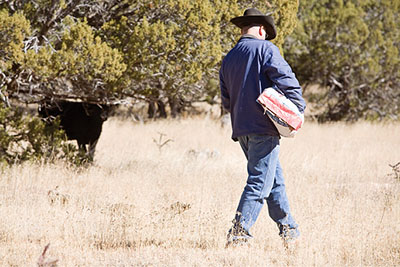
Figure 1. Hand-feeding is an excellent method to control livestock location and movement, while minimizing variation in supplement intake.
Hand-Feeding Versus Self-Feeding
Supplement delivery methods can be broadly classified as hand-fed or self-fed systems. Hand-feeding implies that the supplement is regularly delivered to the animals in a form and amount that is immediately consumed (Figure 1). Self-fed supplements are made available in bulk amounts at infrequent intervals (Figure 2), with the expectation of continuous, low-level consumption by livestock. Self-fed supplements are designed to limit intake so that animals consume only small portions of the available feed at each meal. Intake may be limited by the supplement’s physical form (e.g., hardened molasses blocks), a palatability factor (salt, phosphoric acid, etc.), or a combination of these elements.
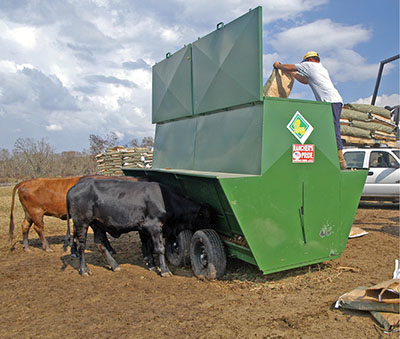
Figure 2. Self-fed supplement delivery can be an effective way to provide nutrients to livestock (photo by Win Henderson, FEMA).
Self-fed supplements have several advantages. They can reduce labor costs since delivery times are designed to be less frequent than with hand-feeding. If supplements are to be consumed at low amounts (e.g., mineral supplements), then self-feeding may be very cost effective. Another advantage of self-feeding systems is that animals can consume supplement every day. This is mainly an advantage with energy or mineral supplements.
The design of feed troughs or bunks for self-feeding systems is important for several reasons. Intake limiters, such as salt or phosphoric acid, may corrode metal feeders, reducing their useful life. Constructing troughs that last longer may reduce portability and limit flexibility in location of feeding areas.
There are some disadvantages to self-feeding systems to consider when weighing options. If livestock are checked at times other than feeding, the savings in labor and associated costs may be less than expected. For supplements that are targeted for more than 1 lb per day consumption, weekly delivery may still be required due to lack of feed bunk volume or the desire to keep feeds fresh. Also, if there is a reduction of total available forage (e.g., due to drought), animals will overconsume these supplements, which can result in digestive upset and reduced performance. Therefore, self-feeding systems for energy supplements specifically may not be appropriate every year.
Based on this comparison, if a self-fed supplement costs significantly more than a hand-fed supplement, any labor cost savings may be offset. However, for energy or mineral supplements (which require daily or alternate day feeding), self-fed supplements may be more economical, even at a higher price per ton, because both labor and transportation costs are reduced. Furthermore, in rough or poorly accessible areas, self-fed supplements may be the only viable solution since the producer may have limited ability to deliver feed to the animals.
Hand-feeding is often used as a method to control livestock location and movements. This may be an advantage or a disadvantage, depending upon circumstances. When animals become accustomed to coming to a vehicle and receiving feed, they may be easier to gather and/or check. However, on public land or private land with easements, animals may begin following all vehicles, which can be a problem. In this situation, self-fed supplements may be more desirable.
Scientists at both New Mexico State University and Texas A&M University’s San Angelo Experiment Station have shown that hand feeding protein supplements once a week results in the same level of performance as feeding three times per week or daily (Huston et al., 1999; Wallace et al., 1992). Therefore, when supplementing protein, the labor required for hand-feeding can be similar to self-feeding (Table 1).
|
Table 1. Labor Cost Comparison of Hand-fed and Self-fed Supplements for One Week |
||||
|
Item |
Daily |
3× per week |
1× per week |
Self-feda |
|
Vehicle costsb |
||||
|
Feeding |
$121.80 |
$52.20 |
$17.40 |
0 |
|
Checking cowsc |
0 |
0 |
$17.40 |
$34.80 |
|
Labor costs |
||||
|
Feedingd |
$168.00 |
$72.00 |
$24.00 |
0 |
|
Checking cowse |
0 |
0 |
$18.00 |
$36.00 |
|
Totals |
$289.80 |
$124.20 |
$76.80 |
$70.80 |
|
aSelf-fed supplement delivered to the pasture by the feed dealer. bVehicle cost of $0.58/mile; assumes a 30-mile round trip. cExpenses for checking cows are included in daily and 3× weekly feeding. Additional costs will be incurred when feeding 1× weekly or self-fed. dLabor cost of $12.00/hr. Feeding requires 1 hour of driving and 1 hour for feeding. eChecks require 1 hour of driving and 0.5 hour observing cows. |
||||
Feeding Technology
Many new technologies have come on the market that address some of the challenges associated with supplementing cattle on range. There are now state of the art self-feeding delivery systems that track and regulate daily intake of supplement. Through electronic ear tag identification, cattle will be allotted a fixed rate of feed per day; if an animal attempts to exceed that allotment, they will not be given access to the feed. Another system will dispense a set amount of feed and automatically call cattle to the feeder using a noise-making device. Though these automated systems are designed to reduce time and control feed costs, the cost of maintaining them may outweigh the savings in feed and labor. This should be considered before purchasing these kinds of systems.
Even with this precise intake regulation, self-feeding systems like these have some of the same issues as traditional feeding. The day to day variability in intake per animal, along with the percentage of animals that do not utilize the feeders at all, can result in reduced performance and efficiency (Williams et al., 2018).
Supplement Form
The practicality of supplement delivery systems on a particular ranch is often strongly influenced by the form (e.g., cake, block, liquid) of the supplemental feed. The various forms of supplements each offer advantages and disadvantages. This section will cover the forms of supplements available, how they are fed, and important considerations for producers regarding each form.
Dry Feeds
Dry feeds are primarily composed of dry ingredients combined to meet nutrient specifications (some dry feeds include a small amount of molasses to improve palatability and binding characteristics). These feeds can be further processed into various forms or left as an unprocessed mix (meals). A potential advantage of all dry feeds is flexibility in formulation. Once nutrient specifications are determined, a formulation based on the cheapest combination of ingredients can be created to minimize cost. For example, if cottonseed meal becomes expensive, then another protein source like sunflower meal might be easily substituted into the formula.
Meals. Meals typically are combinations of dry ingredients mixed together with no further processing. Meals are a common form of range mineral supplements because ingredients in these supplements are difficult to bind together, and the loose form encourages consumption. However, overconsumption is also more common with some meal forms of supplement. Salt is an ingredient that is commonly used to limit meal intake. It is easy to include in order to regulate self-feeding supplement consumption. Salt-limited protein meals have been used successfully in the past. Animals may develop a tolerance to salt over time (and increase intake of the supplement), but with meal supplements, producers can add salt by hand to adjust intake to desired levels. This is an advantage for a self-feeding program.
A disadvantage of meals is that they must be placed into some type of trough or feeder because feeding on the ground results in excessive waste of supplement. Fortunately, since mineral supplements are delivered in relatively low quantities, only a small investment in storage and trough space is required. For energy and protein supplements, more trough space is required, and therefore a potentially larger investment in equipment is needed.
Crumbles. Crumbles are dry feeds that are mixed and pelleted, then crushed to produce smaller particles. Crumbles are most often associated with poultry feeds, but some manufacturers have produced mineral supplements in this form. These mineral supplements have been marketed as having higher environmental (wind and moisture) resistance than loose mineral meals. Research from New Mexico State University indicates that wind losses are minimal with loose mineral mixes (Dean et al., 1999). Therefore, this benefit may only be realized in extremely windy locations. Crumbles may reduce sifting of fine materials and leaching of ingredients due to precipitation, but this has not been well documented for mineral supplements.
Cubes/cake/pellets. Cubes, cake, or pellets all refer to essentially the same feed form. Cubes, the most common form of dry feed used for hand-fed range protein supplements, are available in a variety of sizes. They can be ordered in bulk for distribution by a bulk feeder or purchased in sacks. Bulk feeds reduce the labor associated with handling and often reduce the price of the supplement, but they require a relatively large initial investment in storage and equipment. Pellet feeding allows some control over livestock distribution since animals can usually be led to a desirable feeding area. Cubes are often fed on the ground (Figure 3), but this may be difficult in snow or mud. For hand-fed supplements, cubes usually have the lowest variation in supplement intake by animals (Bowman et al., 1997). This is especially evident when feed is provided three or fewer times per week (Huston, 2000).
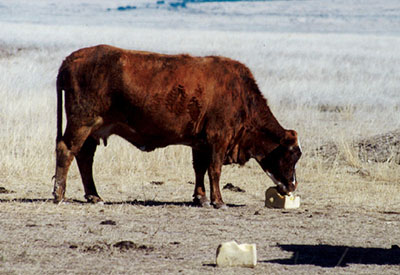
Figure 3. Mineral supplements can be delivered in the form of pressed blocks. Protein and energy supplements can also be delivered as blocks.
A few manufacturers offer self-fed cubes that include an intake limiter (usually salt). As with other self-fed supplements, a feeder is required. This type of self-feeding system may be acceptable under some conditions. However, animals may develop a tolerance for the intake limiter, and intake may increase over time. With self-fed cubes, it is difficult for producers to adjust intake by adding salt since particle size differences will result in sorting.
Dry or pressed blocks. Dry or pressed blocks are essentially very large cubes. These blocks offer similar advantages for formulation flexibility as other dry feeds. Blocks offer an intermediate option between a true self-fed system and a hand-fed system. They can be manufactured with varying degrees of hardness to influence supplement intake. Harder blocks reduce intake, while softer blocks increase intake. Depending on the targeted intake amount, proper hardness can be determined, and the blocks can be used as a self-fed supplement. Blocks that are excessively hard may result in poor consumption or even tooth damage and loss, while extremely soft blocks may encourage overconsumption of supplement.
Regardless of the delivery frequency, old blocks should be completely eaten before the new ones are delivered to ensure adequate nutrient intake. Individual animal consumption of blocks may be more variable than cubes or meals of the same formulation (Kendall et al., 1983). However, according to a review conducted by Montana State University researchers, the number of non-eaters is still relatively low and similar to that of pelleted supplements (Bowman et al., 1997). In principle, block feeding allows more timid animals the opportunity to consume the supplement since they can wait until other animals have left the feeding area.
The compact size and shape of blocks may make handling easier, reducing labor and mileage requirements. For example, if more blocks can be loaded than cubes, then producers may not need to return to the storage site when delivering feed to several areas of the ranch.
Liquid Feeds
Liquid feed use has grown significantly in the past 20 years. Liquid feeds for range use are almost exclusively self-fed products and have many of the same advantages and disadvantages of other self-feeding systems (Figure 4). Many liquid feed dealers offer a delivery service, which can eliminate the labor and handling requirements associated with supplementation (as shown in the example of Table 1). However, feed dealers account for their delivery cost when pricing these products, so ranchers must carefully examine the cost of labor and cost per unit of nutrient delivered.
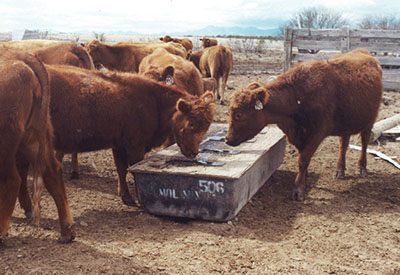
Figure 4. Liquid supplements in lick tanks large enough that they are filled less than once a week.
|
Table 2. Intake Variability and Proportion of Non-eaters of Hardened Molasses Blocks, Hand-fed Dry Supplements, and Self-fed Liquid Supplements |
|||
|
Item |
Molasses blocksa |
Dry |
Liquid |
|
Intake range (lb) |
0–6.0 |
0–3.5 |
0–5.8 |
|
Non-eaters (%)c |
14.3 |
5.0 |
23.5 |
|
aSelf-fed bHand-fed cEstimated intake range includes the middle 97% of animals consuming supplement (some extremes may occur). |
|||
A potential drawback with liquid feeds is the limited number of ingredients that can be utilized in formulations. While this may stabilize prices, it also reduces the opportunity to take advantage of less expensive commodities. Although suspension technologies are improving, it is still difficult to incorporate many dry ingredients into liquid feeds. Therefore, most protein sources used in liquid feeds contain a high proportion of non-protein nitrogen and highly soluble natural proteins.
As with other self-feeding systems, liquid supplement intake is more variable than that of hand-fed supplements. When data from several studies of group-fed animals were compiled, the percentage of animals that did not eat any liquid feed ranged from 17% to 49% (Bowman et al., 1997). In a New Mexico State University trial conducted over two years, 17% of the cows did not consume any liquid supplement. Supplement intake ranged from 0 to 5.4 lb per day (Pulsipher, 2000), which is consistent with the range reported in other studies. This indicates that, while the average performance of a herd may be similar among liquid feeds and dry feeds, the uniformity of individual animal performance response may be lower with liquid supplements. Very few research trials have attempted to directly address this question.
Hardened molasses blocks. Hardened molasses blocks (often referred to as “tubs” or “soft-pours”; Figure 5) share some characteristics with both pressed blocks and liquid feeds. This type of supplement is generally made from a molasses base, like a liquid feed, but is cooked or chemically hardened to create a block-type feed. These supplements can incorporate a higher percentage of dry ingredients than liquid feeds. Due to the amount of molasses in the formulation, they typically have lower amounts of dry feedstuffs than pressed blocks.
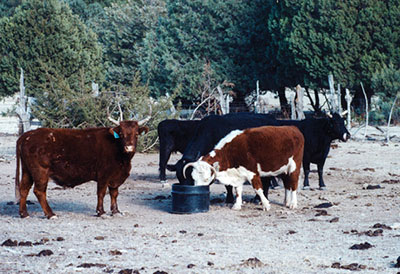
Figure 5. Soft-pours are commonly used as a self-fed method to deliver supplements.
Hardened molasses blocks are self-fed supplements. As animals lick the block, saliva softens the surface and allows the animals to scrape off the softened portion. Intake is dependent on the rate of softening. Harder blocks are designed for slower consumption (lower intake) and do not soften as easily. However, increasing block hardness to reduce intake of molasses blocks also increases intake variability (Kendall et al., 1983). When compared with hand-fed dry supplements or liquid feeds under a variety of conditions, molasses blocks had the highest variation in individual animal intake (Table 2; Bowman et al., 1997).
Molasses blocks are more environmentally resistant than pressed blocks, and the delivery frequency can therefore be decreased. However, since livestock must be checked periodically, the total labor cost associated with feeding hardened molasses blocks may not be significantly less than feeding dry supplements once per week.
Something to consider when utilizing protein tubs specifically are the empty containers. Feed companies no longer provide rebates on the empty tubs. This can lead to a waste issue that would require additional product handling. There are products with biodegradable containers, but this option can be more expensive.
Ingredient Technology
Non-protein nitrogen (NPN) sources like urea or liquid fermentation byproducts can provide an excellent opportunity to reduce overall feed costs. These are most commonly found in liquid feed supplements, but may also be included as an ingredient in pressed blocks and high-protein cubes. It is important to remember that the utilization of NPN is limited with low-quality diets (NAESM, 2016). Non-protein nitrogen occurs naturally in many feedstuffs (an example is lush pasture such as wheat), and is well utilized in the rumen if adequate energy is present in the diet. Excessive NPN in the supplement, coupled with slow energy release from dormant forage, can result in inefficient NPN use, potentially reducing animal performance. To address the potential issue of forage digestibility, feed manufacturers now offer slow-release NPN additives to better match the rumen environment of low-energy diets.
Manufacturers have also improved technology to incorporate fat into their products. Fat offers 2.25 times the energy of carbohydrates, but can present challenges when added to feedstuffs. Product shelf life, stability, and the pelleting process can be negatively impacted in added-fat supplement formulas. Through research and development, there are now cubes, pressed blocks, and liquid feed formulations that contain greater than 3% crude fat. Increased fat in the diet can be beneficial to help young heifers continue to grow through the winter, or add condition to thinner cows. Price, feeding rates, and palatability should be considered when selecting an added-fat product. Palatability and forage digestibility in the rumen may be negatively impacted if dietary fat exceeds a certain level. When heifers were fed a ration containing either a 3% or 6% level of soybean oil, those on the higher-fat diet had reduced feed efficiency (Funston, 2004). Today’s added-fat products generally contain 4–5% fat, which falls within the range that will not affect forage digestibility, but will add overall beneficial energy to the diet.
Considerations
Supplemental feeds are designed to provide a given level of nutrients to each animal in the herd. Much of the variation in response to supplementation programs has been attributed to variation in supplement intake by individual animals (Huston, 2000). Researchers at Montana State University compiled intake data from both sheep and cattle under a wide variety of environments and supplement formulations, and found that 5% of hand-fed animals failed to consume any supplement, while 19% of self-fed animals did not consume any supplement (Bowman et al., 1997). The total variation in supplement intake was twice as high for self-feeding compared to hand-feeding. This may result in substantial variation in response to a supplemental feeding program since many animals fail to consume the targeted amount, while others consume in excess.
Intake variation also occurs with hand-fed supplements, but the variation is generally less dramatic. Depending on the acceptance of the supplement and the effectiveness of the intake limiter, more variation in animal performance may occur with self-fed supplements. Supplement intake variation depends on factors unique to each operation. However, producers should be aware of the potential for greater variability in self-fed supplement intake, and therefore more variability in the performance responses to these supplements. If total available forage is not adequate to meet daily intake requirements, cattle will overconsume self-feeding protein and energy supplements. This can not only cause an increase in daily costs but can also have detrimental effects on rumen health and animal performance.
Additionally, trough space greatly influences the variation in intake and the number animals that fail to eat supplement (Bowman et al., 1997). Trough space of 2.5 ft per head appears to be ideal for range cows to minimize intake variation and allow more cattle to consume the supplement (Wagnon, 1965). For sheep, ideal trough space is approximately 10 in. per head (Arnold et al., 1974).
General Conclusions
A variety of supplement types are available for range livestock producers. The most efficient and effective supplement delivery system depends on individual circumstances and may vary from ranch to ranch. For energy and mineral supplementation, self-fed delivery methods are probably more labor efficient since these supplements should be consumed on a daily or every other day basis. With energy supplements, large quantities are usually supplied, and even with self-fed supplements the supply may need to be replenished frequently. When feeding protein supplements, less frequent feeding (up to once per week) is as effective as daily delivery, and labor costs may be reduced to levels similar to those of self-fed supplements with less intake variation.
Different supplement delivery systems have different advantages and disadvantages. The overall benefit of using a particular system depends on the individual situation. Supplement delivery systems can be ranked (1 = best) based on several different criteria.
Flexibility of least-cost formulation:
- Cubes or meals
- Pressed blocks
- Hardened molasses blocks
- Liquid feeds
Labor and delivery costs:
- Liquid feeds, dealer filling feeders
- Hardened molasses blocks
- Small package meals (e.g., mineral)
- Pressed blocks
- Hand-fed cubes
Flexibility of feeding location:
- Cubes
- Small package meals
- Blocks (any type)
- Liquids
- Large package meals (protein or energy)
The primary goal of any supplementation program is to deliver targeted amounts of specific nutrients in a uniform and consistent manner to generate predictable results. Variability in supplement intake is a major cause of variable performance responses to a supplemental feeding program. Some systems may deliver nutrients more precisely, but the costs and benefits of each system should be evaluated.
Literature Cited
Arnold, G.W., and R.A. Maller. 1974. Some aspects of competition between sheep for supplementary feed. Animal Production, 19, 309–319.
Bowman, J.G.P., and B.F. Sowell. 1997. Delivery method and supplement consumption by grazing ruminants: A review. Journal of Animal Science, 75, 543–550.
Dean, T.L., R.C. Waterman, J.E. Sawyer, M.K. Petersen, and G.B. Donart. 1999. Effectiveness of loose zinc sulfate supplementation on average daily gain (ADG) of stocker cattle grazing native range. In Proceedings, Western Section American Society of Animal Science, 50, 176–179.
Funston, R.N. 2004. Fat supplementation and reproduction in beef females. Journal of Animal Science, 82, E154–E161.
Huston, J.E. 2000. Frequency of feeding supplements to cattle. In Proceedings, 2000 Plains Nutrition Council Fall Grazing Conference, 18.
Huston, J.E., H. Lippke, T.D.A. Forbes, J.W. Holloway, and R.V. Machen. 1999. Effects of supplemental feeding interval on adult cows in western Texas. Journal of Animal Science, 77, 3057–3067.
Kendall, P.T., M.J. Ducker, and R.G. Hemingway. 1983. Individual intake variation in ewes given feedblock or trough supplements indoors or at winter grazing. Animal Production, 36, 7–19.
National Academies of Sciences, Engineering, and Medicine. 2016. Nutrient requirements of beef cattle, eighth rev. ed. Washington, D.C.: National Academies Press. doi: 10.17226/19014.
Pulsipher, G.D. 2000. Supplemental nutrients for beef cows and heifers consuming low-quality forages [Ph.D. dissertation]. Las Cruces: New Mexico State University.
Wagnon, K.A. 1965. Social dominance in range cows and its effect on supplemental feeding [Bulletin 819]. Davis: University of California Agricultural Experiment Station.
Wallace, J.D., and E.E. Parker. 1992. Range supplements—What we have learned. In Cattle Growers’ Short Course, 20–27. Las Cruces: New Mexico State University.
Williams, G.D., M.R. Beck, L.R. Thompson, G.W. Horn, and R.R. Reuter. 2018. Variability in supplement intake affects performance of beef steers grazing dormant tallgrass prairie. Journal of Applied Animal Science, 34, 364–371.
For Further Reading
B-224: Cow Herd Vaccination Guidelines
pubs.nmsu.edu/_b/B224/
B-230: Trichomoniasis in Beef Cattle
pubs.nmsu.edu/_b/B230/
Guía B-230: Tricomoniasis en el ganado de carne
pubs.nmsu.edu/_b/B230sp/
CR-648: Using Anti-suckling Devices to Wean Beef Calves
pubs.nmsu.edu/_circulars/CR648/

Marcy Ward Marcy Ward is the Extension Livestock Specialist at NMSU. She received her B.S. and M.S. in animal science from Colorado State University and NMSU, respectively, and her Ph.D. in ruminant nutrition from North Dakota State University. She was most recently the Beef Program Director at Colby Community College in Colby, KS.
To find more resources for your business, home, or family, visit the College of Agricultural, Consumer and Environmental Sciences on the World Wide Web at pubs.nmsu.edu.
Contents of publications may be freely reproduced, with an appropriate citation, for educational purposes. All other rights reserved. For permission to use publications for other purposes, contact pubs@nmsu.edu or the authors listed on the publication.
New Mexico State University is an equal opportunity/affirmative action employer and educator. NMSU and the U.S. Department of Agriculture cooperating.
Revised April 2020 Las Cruces, NM


